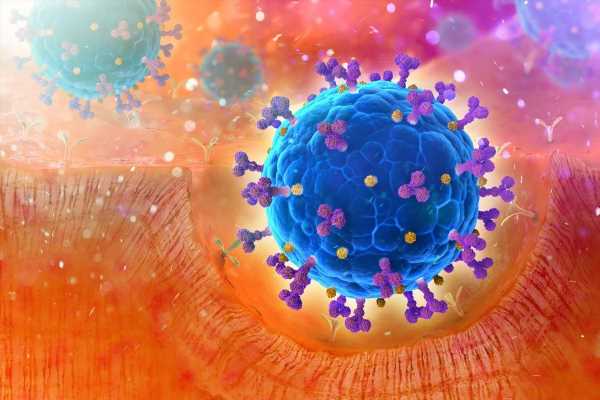In a recent study posted to the bioRxiv* preprint server, researchers evaluated the initial three days of severe acute respiratory syndrome coronavirus 2 (SARS-CoV-2) infection via single-cell RNA sequencing (scRNAseq) dataset in humanized in vitro model.
 Study: SARS-CoV-2 leverages airway epithelial protective mechanism for viral infection. Image Credit: Andrii Vodolazhskyi/Shutterstock
Study: SARS-CoV-2 leverages airway epithelial protective mechanism for viral infection. Image Credit: Andrii Vodolazhskyi/Shutterstock
Background
The ongoing coronavirus disease 2019 (COVID-19) pandemic has claimed over 5.57 million lives globally since its initial outbreak in 2019. A better understanding of the SARS-CoV-2 infection dynamics is required to treat the disease and fully overcome the threat of COVID-19.
However, there is limited understanding of early SARS-CoV-2 viral entry and infection dynamics in the respiratory tracts, despite extensive global efforts to understand the SARS-CoV-2 infection pattern. The limited knowledge about the early phases of the SARS-CoV-2 infection is inversely proportional to higher mortality rates associated with COVID-19.
About the study
In the present study, the researchers determined the primary mechanism by which SARS-CoV-2 triggers the cellular- and system-level responses in the bronchial epithelium by evaluating the scRNAseq dataset of early SARS-CoV-2 infection in the in vitro air-liquid interface (ALI) model of proximal airway epithelium.
The scRNAseqs were obtained from a previous study, in which after the SARS-CoV-2 inoculation into the ALI cultures of differentiated human bronchial epithelial cells (HBECs), the samples were collected one day post-infection (1dpi), two dpi (2dpi), and three dpi (3dpi). Further, the scRNAseqs of the samples collected at three time stamps and an uninfected mock condition were evaluated through de novo analysis.
With the help of viral transcripts indicating SARS-CoV-2, the viral load concentrates and initiates in the ciliated cell clusters were determined. The ciliated cluster cells were re-analyzed for an in-depth understanding of progenitor cells.
Mapping the scRNAseq against the FANTOM5 database of ligand-receptor interactions revealed cell-cell communication in the SARS-CoV-2-bronchiolar tissue interaction.
Findings
The results indicated that the SARS-CoV-2 gains entry into the tissue via precursors of ciliated cells such as those differentiating from secretory or basal-secretory intermediate cells into ciliated cells. The subsequent differentiation of the SARS-CoV-2-infected progenitors of ciliated cells resulted in a mass of mature ciliated cells infected by SARS-CoV-2. The SARS-CoV-2-infected mature ciliated cells further induced rapid differentiation of the basal cells to restore the injured ciliated epithelial cells resulting in a short-term depletion of the resident basal cells. Additional cell-cell communication mitigated the feed-forward circuit of infection before interferon (IFN) signaling occurred 3dpi of SARS-CoV-2.
By the third day of SARS-CoV-2 infection, the numbers of basal cells replenished due to the partial restoration of the renewal rate of basal cells. These basal cell population dynamics were associated with a short-term increase in factors affecting the differentiation and renewal of basal cells secreted by a newly identified mass of SARS-CoV-2-infected ciliated cells, named novel infected ciliated cells (NICs).
The NIC, independent from other progenitor and mature ciliated cells infected by SARS-CoV-2, has an almost 100% SARS-CoV-2 infection rate, indicating that it emerged from SARS-CoV-2-infected ciliated cells. NIC demonstrated a rapid downregulation of angiotensin-converting enzyme 2 (ACE2) receptors together with suppression of other genes for oxidative stress responses, probably due to SARS-CoV-2 infection. Furthermore, SARS-CoV-2-associated oxidative stress decreased the expression of nuclear factor erythroid 2–related factor 2 (Nrf2) in respiratory pathways.
The factors enhancing the differentiation of the basal and ciliated progenitor cells, including transforming growth factor β (TGFβ), were probably secreted due to the elevated oxidative stress associated with the SARS-CoV-2 infection.
Conclusions
The study findings demonstrated that by leveraging mechanisms that are potentially beneficial in airway epithelial tissue repair, SARS-CoV-2 leads to worsened disease outcomes. The study provided an in-depth understanding of the interaction between SARS-CoV-2 infection and barrier tissues. Moreover, the findings suggested alternative COVID-19 therapeutic strategies directed towards innate immunity by elucidating the vulnerability of innate immunity of the airway epithelial tissues during the initial days of the SARS-CoV-2 infection.
SARS-CoV-2 hijacks the depletion of basal cells followed by their differentiation to maintain the proportion of ciliated cells, which is a potential tissue repair mechanism due to the affinity of SARS-CoV-2 towards dividing progenitor cells rather than stable matured cells. A similar mechanism of viral entry was observed previously in placental infection associated with human cytomegalovirus and Zika virus.
Further, the downregulation of ACE2 receptors and other genes exhibiting oxidative stress responses in SARS-CoV-2-infected cells lead to reduced multiplicity of infection (MOI) in single cells infected with SARS-CoV-2 and increases the viral yield by enhancing the survival of the cells.
The findings indicated that the basis for the lower SARS-CoV-2 infection rate among children was their naturally high epithelial regenerative capacity. As the airway epithelial regenerative capacities decrease with age, this protective mechanism is rare in older individuals.
Previous studies reported a possible reduction in ACE2 expression in humans with age, a phenomenon already demonstrated in animal models and less frequently found in females. Interestingly, the present study suggested the significance of the age-related decrease in expression of Nrf2 in respiratory pathways. It is known that ACE2 acts as a target for the activation of Nrf2. Hence, the elderly and those with alterations in ACE2 expression because of comorbid conditions are associated with a lower SARS-CoV-2 infection rate and higher severity rate.
Overall, the study provided a framework for understanding the gender- and age-related variations of COVID-19 severity. Further, it also demonstrated a potential COVID-19 prophylactic or therapeutic intervention through identifying the systemic vulnerability in SARS-CoV-2 infection.
*Important notice
bioRxiv publishes preliminary scientific reports that are not peer-reviewed and, therefore, should not be regarded as conclusive, guide clinical practice/health-related behavior, or treated as established information.
-
Greaney, A. et al. (2022) "SARS-CoV-2 leverages airway epithelial protective mechanism for viral infection". bioRxiv. doi: 10.1101/2022.01.29.478335. https://www.biorxiv.org/content/10.1101/2022.01.29.478335v1
Posted in: Medical Science News | Medical Research News | Disease/Infection News
Tags: ACE2, Angiotensin, Angiotensin-Converting Enzyme 2, Cell, Children, Coronavirus, Coronavirus Disease COVID-19, covid-19, Cytomegalovirus, Enzyme, Genes, Growth Factor, immunity, in vitro, Interferon, Ligand, Mortality, Oxidative Stress, Pandemic, Progenitor Cells, Receptor, Respiratory, RNA, RNA Sequencing, SARS, SARS-CoV-2, Severe Acute Respiratory, Severe Acute Respiratory Syndrome, Stress, Syndrome, Virus, Zika Virus

Written by
Shanet Susan Alex
Shanet Susan Alex, a medical writer, based in Kerala, India, is a Doctor of Pharmacy graduate from Kerala University of Health Sciences. Her academic background is in clinical pharmacy and research, and she is passionate about medical writing. Shanet has published papers in the International Journal of Medical Science and Current Research (IJMSCR), the International Journal of Pharmacy (IJP), and the International Journal of Medical Science and Applied Research (IJMSAR). Apart from work, she enjoys listening to music and watching movies.
Source: Read Full Article
